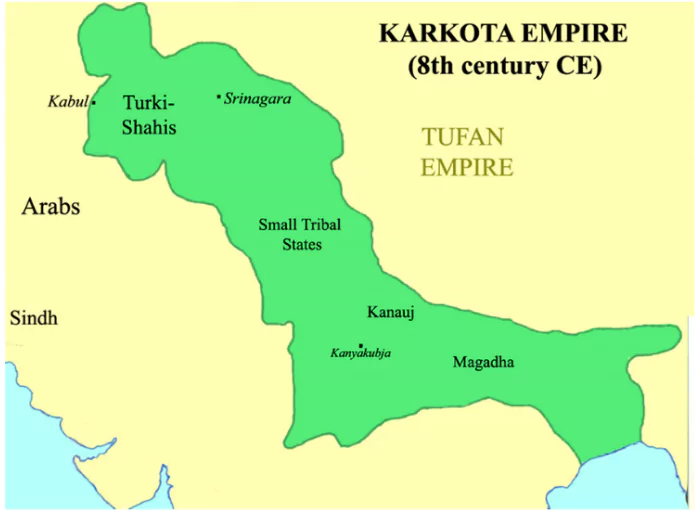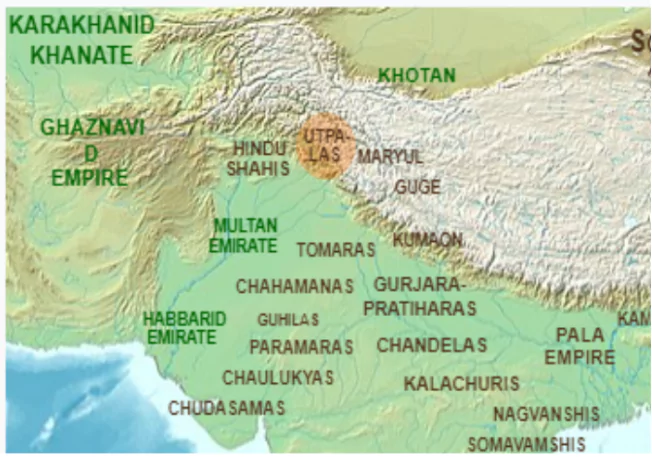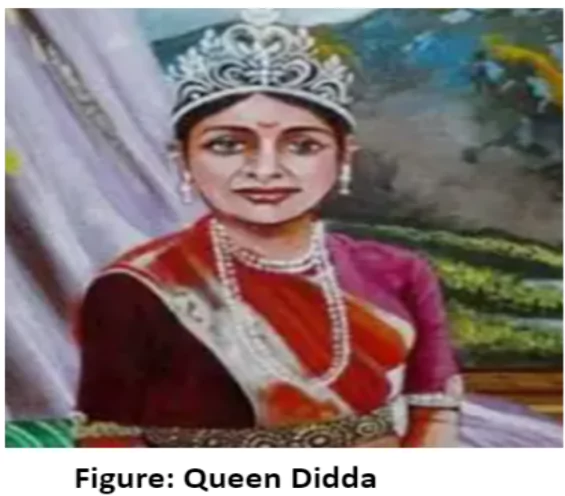Introduction
The medieval history of Kashmir is rich with the legacies of powerful dynasties, each leaving an indelible mark on the region’s culture and governance. Among these, the Karkota and Utpala dynasties stand out for their political prowess and cultural contributions. Following the decline of the Utpala dynasty, Kashmir witnessed a period of unrest and power struggles, leading to the emergence of Queen Didda as a prominent figure in the region’s history.
1. The Karkota Dynasty: Builders of Kashmir’s Legacy
- Founding of the Dynasty: Durlabhavardhan, under the patronage of the last Gonanda ruler, established the Karkota Dynasty.
- Married Gonanda’s daughter to claim legitimacy.
- Constructed the Durlabhasvāmin Vishnu shrine and introduced new architectural styles from post-Gupta trends.
- Political and Economic Prosperity: Ruled over Kashmir and parts of northern India.
- Implemented various taxes including customs and market taxes.
 Witnessed a period of political expansion and economic growth.
Witnessed a period of political expansion and economic growth.- Cultural and Religious Contributions: Built numerous Vishnu shrines and Buddhist monasteries.
- Commissioned the Martand Sun Temple, an ancient Sun temple complex.
- Encouraged Buddhism alongside Vaishnavism.
- Notable Rulers: Lalitaditya, the greatest ruler, constructed the Martand Sun Temple and established multiple towns.
- Jayapida, who established Buddhist viharas and commissioned Buddha statues.
- Candrapika, known for installing multiple Vishnu shrines.
- Legacy and End of Rule: The Karkota Dynasty’s rule ended with the ascension of Avanti Varman of the Utpala dynasty in 855 A.D.
- Cultural Heritage: The ruins of their capital contain Stupas, Chaityas, and Viharas, showcasing their rich cultural heritage.
Enroll now for UPSC Online Course
2. Establishment of the Utpala Dynasty
- Founder: Avantivarman established the Utpala dynasty after the end of the Karkota dynasty in Kashmir around 855 CE.
- He claimed the throne with the help of his minister Sura.
- Reign of Avantivarman:
- Avantivarman (855-883 AD): the founder of the Utpala dynasty, significantly developed drainage and irrigation systems to provide relief from floods.
- He founded the town of Avantipur and built many temples
 His reign was marked by innovations in irrigation and water management by his minister Suyya.
His reign was marked by innovations in irrigation and water management by his minister Suyya.
- Succession Struggles: After Avantivarman’s death, power struggles ensued among his maternal uncles and sons.
- Multiple battles were fought, leading to shifts in power.
- Reign of Samkaravarman: Samkaravarman, succeeding Avantivarman, waged successful military campaigns.
- His later years were marked by oppression and fiscal greed, leading to discontent among the populace.
- Downfall and Succession: Samkaravarman’s reign ended with his death in 902 CE.
- Succession struggles continued, leading to short reigns and further instability in the kingdom.
- End of the Utpala Dynasty: The Utpala dynasty ended with the ascent of Kamalvardhana, who overthrew Suravarman II.
- Yasaskara: son of Prabhakaradeva, was chosen as the next ruler, bringing an end to the Utpala dynasty.
3. Reign of Queen Didda

- Queen Didda: The reign of the renowned Queen Didda was marked by unrest and led to the rise of the Lohara dynasty.
- Didda, also known as the “Catherine of Kashmir,” was a significant ruler during the Utpala Dynasty.
- Her rule is detailed in Kalhana’s Rajtaranghni.
- Marriage and Ascension to Power: Didda married Kshemagupta of the Parthagupta dynasty to legitimize his power.
- She was physically disabled, but she exhibited shrewd political acumen.
- Rule and Governance: Didda ruled Kashmir for over half a century, displaying traits of manipulation and ruthlessness.
- She effectively exercised power during her son Abhimanyu’s reign as a regent.
- Opposition and Suppression: Didda faced opposition from her husband’s nephews, whom she ruthlessly suppressed.
- She employed strategic alliances and bribery to maintain her rule.
- Legacy and Succession:
- Didda’s reign saw brutal executions and suppression of dissent.
- Upon her death, the throne passed to her nephew Samgramaraja, establishing the Lohara dynasty.
- Period of Anarchy: The dynasty’s fall in 1172 resulted in two centuries of anarchy, ending with Shah Mir’s deposition of Queen Kota in 1339, marking the cessation of Hindu rule in Kashmir.
Enroll now for UPSC Online Classes
Conclusion
The medieval era in Kashmir was characterized by the rise and fall of influential dynasties, each shaping the region’s destiny in its own way. From the architectural marvels of the Karkota dynasty to the political intrigue of the Utpala rulers, Kashmir’s history reflects the complexities of power and governance. Queen Didda’s reign marked a tumultuous period, ultimately paving the way for the end of Hindu rule in Kashmir and the dawn of a new era under the Lohara dynasty.
![]() May 14, 2024
May 14, 2024
![]() 7738
7738
![]() 0
0
 Witnessed a period of political expansion and economic growth.
Witnessed a period of political expansion and economic growth. His reign was marked by innovations in irrigation and water management by his minister Suyya.
His reign was marked by innovations in irrigation and water management by his minister Suyya.